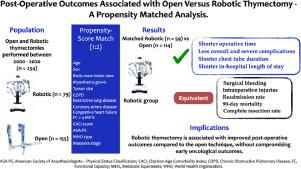Seminars in Thoracic and Cardiovascular Surgery ( IF 2.6 ) Pub Date : 2021-11-25 , DOI: 10.1053/j.semtcvs.2021.11.011 Stephan A Soder 1 , Clare Pollock 1 , Pasquale Ferraro 1 , Edwin Lafontaine 1 , Jocelyne Martin 1 , Basil Nasir 1 , Moishe Liberman 2

|
To compare post-operative outcomes associated with thymectomy performed using either open or robotic approaches. Retrospective cohort study from a single-center prospective registry consisting of patients undergoing thymectomy between 2000 and 2020. Patients were grouped according to surgical approach (open vs robotic). A propensity-score matching analysis was performed in a 2:1 open to robotic ratio, and surgical outcomes were evaluated. We analyzed 234 thymectomies (155 open; 79 robotic). Myasthenia gravis was present in 23.2% and 32.9% (P = 0.249) in the open and in the robotic group, respectively. All covariates were balanced in the matched groups (open n = 114; robotic n =5 9), except lesion size. The robotic approach was significantly associated with shorter surgical time (median 95 vs 65 minutes, P < 0.001), lesser clinical (21.1% vs 6.8%, P = 0.016) and surgical (11.4% vs 1.7%, P = 0.036) complications during the same hospitalization, less Clavien-Dindo grade 2 or higher complication rates (28.1 vs 15.3%, P = 0.048), chest tube duration (median: 3 vs 0 days, P < 0.001) and in-hospital length of stay (median: 5 vs 0 days, P < 0.001). Bleeding (P = 0.214), ICU length of stay (P = 0.167), reoperation rate (open, 1.8% vs robotic 0%), 90-day mortality (P = 0.341) and readmission rate post discharge (P = 0.277) were similar between the groups. In the matched population with primary thymic epithelial tumors, the completeness of resection rate was similar (open, 92.1% vs robotic 96.8%, P = 0.66.). Robotic thymectomy is associated with improved post-operative outcomes when compared to open thymectomy, without compromising the goals of oncologic surgery. Longer follow-up is needed to ensure oncologic equivalence.
中文翻译:

开放式胸腺切除术与机器人胸腺切除术相关的术后结果:倾向匹配分析
比较与使用开放式或机器人方法进行的胸腺切除术相关的术后结果。来自单中心前瞻性登记处的回顾性队列研究,该登记处由 2000 年至 2020 年间接受胸腺切除术的患者组成。患者根据手术方法(开放式与机器人手术)分组。以 2:1 的开放机器人比例进行倾向评分匹配分析,并评估手术结果。我们分析了 234 例胸腺切除术(155 例开放;79 例机器人)。重症肌无力存在于 23.2% 和 32.9% ( P = 0.249) 分别在开放组和机器人组中。除病变大小外,所有协变量在匹配组中均保持平衡(开放式 n = 114;机器人 n = 5·9)。机器人入路与较短的手术时间(中位数 95 对 65 分钟,P < 0.001)、较少的临床并发症(21.1% 对 6.8%,P = 0.016)和手术并发症(11.4% 对 1.7%,P = 0.036)显着相关相同的住院治疗、更少的 Clavien-Dindo 2 级或更高并发症发生率(28.1 对 15.3%,P = 0.048)、胸管持续时间(中位数:3 对 0 天,P < 0.001)和住院时间(中位数: 5 天对比 0 天,P < 0.001)。出血 ( P = 0.214),ICU 住院时间 (P = 0.167)、再手术率(开放式,1.8% vs 机器人 0%)、90 天死亡率 ( P = 0.341) 和出院后再入院率 ( P = 0.277) 在组间相似。在具有原发性胸腺上皮肿瘤的匹配人群中,完全切除率相似(开放式,92.1% vs 机器人 96.8%,P = 0.66.)。与开放式胸腺切除术相比,机器人胸腺切除术可改善术后结果,同时不会影响肿瘤手术的目标。需要更长时间的随访以确保肿瘤学等效性。










































 京公网安备 11010802027423号
京公网安备 11010802027423号